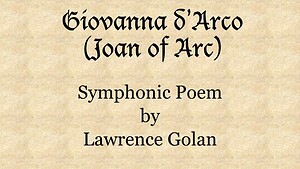
14:47 in length
world premiere October 11, 2023 by Lamont Symphony Orchestra
Dedication: "For my amazing daughter, Giovanna"
The following aspects of Joan’s story are depicted in this symphonic poem:
Rural characteristics of Joan’s birthplace (mm. 1-46): grazing sheep (violas, m. 7 ff.), indigenous birdcalls (Common Greenshank, piccolo, m. 10 ff.; Eurasian Sparrowhawk, oboe, m. 26 ff.), grazing cattle (percussion, m. 15 ff.), crickets (violins, m. 17 ff.), mist (brass, m. 33 ff.)
The Visions (mm. 47-71)
Divine Inspiration (mm. 72-98)
Joan’s transformation from peasant girl to military hero (mm. 99-123) The Battles (mm. 124-171)
Joan’s capture (mm. 172-174)
Joan burned at the stake (mm. 176-192)
Joan’s ascension to Heaven and sainthood (mm. 191-end)
String Bowings. The score and string parts have been completely bowed by the composer (a violinist). There is no need to go through the typical process of having the parts bowed by the string principals.
INSTRUMENTATION
3 flutes (3nd doubles on piccolo), 2 oboes, English horn, 3 clarinets (3rd doubles on bass clarinet), 2 bassoons, contrabassoon, 4 horns, 3 trumpets, 2 trombones, bass trombone, tuba, timpani, percussion (3 players: bass drum, cowbell, crash cymbals, Mark tree, snare drum, suspended cymbal, tam-tam, tenor drum, vibraphone), harp, strings
PROGRAM NOTE
Joan of Arc, or Jeanne d’Arc in French, Giovanna d’Arco in Italian, was born around 1412 in the village of Domrémy, in northeastern France. A peasant girl who was not taught to read or write, Joan claimed to have acted under divine guidance. Specifcally, she said that she had recurring visions of Saint Michael (the Archangel), Saint Margaret (of Antioch) and Saint Catherine (of Alexandria). Joan determined that these visions were sent by God to give her the monumental mission of saving France by expelling the English and installing crown prince Charles of Valois as its rightful king. Joan went on to become a military hero who led the French to victory in several battles, most notably the Siege of Orléans and her march on Reims, enabling the coronation of Charles as King Charles VII.
Joan was eventually captured. She was charged and tried on multiple counts, including witchcraft. After being found guilty, she was burned at the stake in Rouen at the age of 19. However, a new trial ordered by Charles 20 years later cleared Joan’s name. Her fame and reputation continued to grow over the centuries and in 1920 she was canonized by Pope Benedict XV. Joan of Arc is considered one of history’s greatest martyrs and the patron saint of France.

 Back to List
Back to List